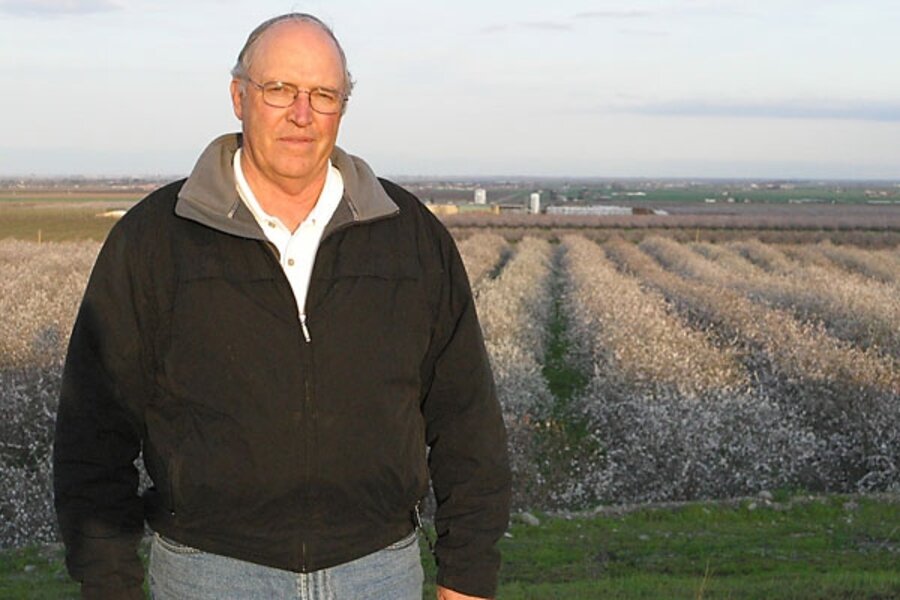Drought hits California farmers hard
| Newman, Calif.
The almond orchards are beginning to bloom in California’s Central Valley, the vast swath of fertile, flat land that runs up and down the middle of the state. Bees are pollinating the rows of flowering trees, and the harvest will shape up over the coming months.
But for many farmers, one crucial thing is missing from this picture – water.
The US Bureau of Reclamation, which manages water allocation in arid regions, announced last week it will not provide vital irrigation to Central Valley farmers this year because of drought, and the California State Water Project expects to meet only 15 percent of water requests.
“That’s unheard-of,” says Jim Jasper, an almond farmer in Newman, Calif. “We’ve never seen a zero allocation for water.” Many growers here are destroying older and less productive trees to conserve water for other crops.
The University of California estimates that the drought may cause 847,000 acres to go unplanted this year, with income reductions of more than $2 billion and the loss of 70,000 jobs.
One of the richest farming regions in the country, the Central Valley covers 18,000 square miles between the Coast Ranges and the Sierra Nevada. It includes the San Joaquin Valley in the south and the Sacramento Valley in the north.
Many farmers and ranchers came here after the gold rush of 1849, and government irrigation projects after World War II allowed farming to expand. The area produces more than 300 crops, including nuts, fruits, vegetables, and grains, and it accounts for one-sixth of US-grown produce.
The Bureau of Reclamation’s Central Valley Project typically supplies about one-fourth of the water used by California farmers. Much of the land has access to groundwater and local irrigation systems, but many farmers on the west side of the San Joaquin valley rely solely on federal water.
There’s always been fierce competition for water in the West.
Much of it goes to wildlife refuges, municipal and industrial use, and to water rights holders from before the current system was established. Some of it is being retained for river flows necessary to the survival of endangered fish species including chinook salmon and the delta smelt.
If California production is drastically reduced, the water crisis could affect American kitchens. In an age when people want fresh, local produce, a reduction could ultimately lead to more imports, warns the California Farm Bureau.
Still, Richard Howitt, professor of Agriculture and Resource Economics at the University of California in Davis says it’s important to keep this drought in perspective. The acreage reduction he estimates at 18 percent will affect the entire supply chain, from farmers, processors, and fieldworkers, to tractor vendors, truck drivers, and gas stations.
But with its Mediterranean climate, California needs to learn to deal with severe droughts, he says. “Yes, it’s going to hurt lots of people. But it’s not the end of the world.”
This is the third year of below-average precipitation, and in mid-January the Sierra snowpack had reached only 61 percent of its normal level. With their dry ridges of waterless land, some of the state’s most important reservoirs are at a fraction of their normal levels.
Compared with California’s last two serious droughts in the 1970s and 1990s, experts say this one could be much worse, especially since the state has added 10 million people in the last two decades.
For now, it’s up to Mother Nature. Unusually high rainfall in the next few months could help to even out the dryness of October through January and prepare for the dry summer months.
“These last three critically dry years have drawn down our reservoirs to the point where it’s going to take a lot of precipitation to make a significant increase in our water levels,” says Bureau of Reclamation spokesman Pete Lucero.
Rain and snowfall in mid-February have been a source of hope. But Mr. Lucero says that’s like “throwing a cup of water into a swimming pool.”
For Richard Waycott, president and CEO of the Almond Board of California, the drought and the pumping restrictions for the state and federal water programs are presenting growers with major challenges.
“It means that people have to make tough decisions,” he says. Some growers will forgo planting other crops to save water for their trees, and some may irrigate just enough to keep the trees alive without producing a harvest for this year. Others will destroy less productive trees.
The California Farm Bureau warns that water shortages could have a lasting impact on California agriculture, a roughly $32-billion-a-year industry. If entire farms go out of business, seed dealers, equipment providers, processing facilities, and others could be affected.
“There are some farmers who may be forced out of business,” says farm bureau spokesman Dave Kranz. That’s what worries Jim Jasper these days.
He’s drilled wells on his 1,800-acre farm of almonds, walnuts, cherries, and citrus, and he’ll try to transfer water from another district where he has more land. He also has access to some irrigation as a result of conservation last year. But it may not be enough.
“A lot of money has been put into these lands,” he says, referring to water projects from the 1950s like the irrigation canal that runs beside his orchards. “Without water, it’s going to dry up.”
In recent decades, farmers have begun to use drip irrigation, soil probes, and aerial photographs to pinpoint dry areas, as well as improved weather forecasting to know when they’ll need irrigation. Productivity per acre has nearly doubled since the 1960s, with little increase in water usage.
But, says Kranz of the state farm bureau, “We can’t conserve our way out of this. The numbers are just too daunting.”





